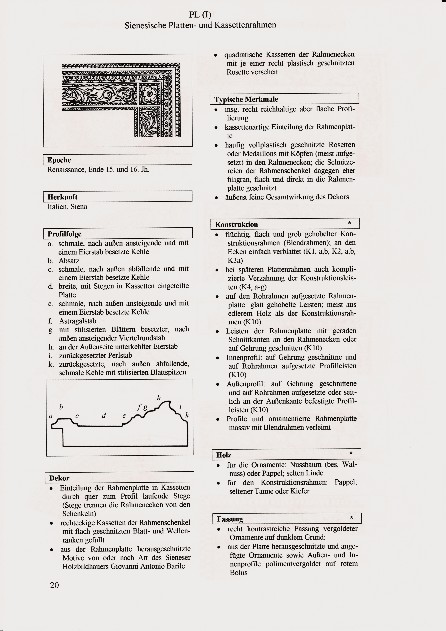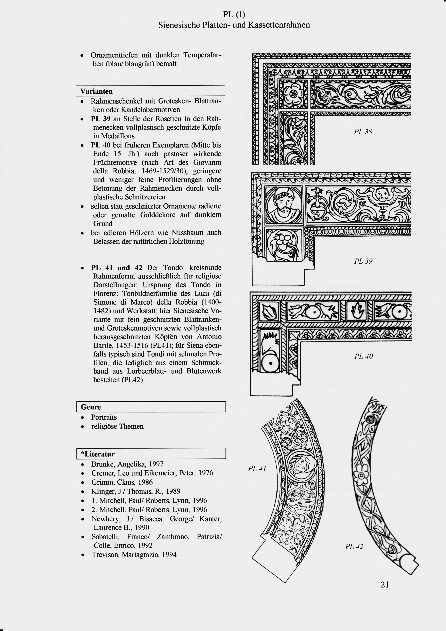schmitzrahmen.de
Volume 1
Up to now the only reference work on
European picture frames
from the Renaissance to Neoclassicism:
271 Pages
510 drawings of frame corners
83 drawings of profiles
23 drawings of constructions
Format 27 x 21 cm
Language: German
Hardback with silver print, bound with thread stitching
ISBN 3-00-011231-6
The lexicon provides:
* fast, reliable classification of a present historical picture frame in the sense of an identification book
* more certitude of the historical correctness of the frames around old old masterly paintings
* a fast overview of picture frame styles through clear presentation of the illustrations and detailed descriptions
* includes not only conventional and original style forms, but also regional and national variants and replicas
The lexicon is especially suitable for restorers, curators, gallerists, frame and antique dealers, art and picture frame collectors, frame makers, auction houses, academies, art colleges and art institutes. As part of the dissertation "Analysis and Evaluation of the Contemporary Framing Procedures of Selected Museums", the lexicon was awarded the Lempertz Prize in 2006 for distinguished scientific work. See Author for more information.
Reviews of the lexicon in specialist journals:
RESTAURO (journal for restorers, Edition no. 8, December 2003)
DER KUNSTHANDEL ("The Art Trade", journal for art dealers and picture framers, Edition November 2004, p. 54)
Exposé: profiles, woods, frames, variants and much more:
"Schmitz Lexikon der europäischen Bilderrahmen: von der
Renaissance bis zum Klassizismus"
As early as the year 1912 Wilhelm von Bode - a veritable authority on the Berlin museum scene in the early 20th century - wrote about the compilation of a handbook of European picture frames:
In an essay on >picture frames then and now< […] I designed an outline for the development of picture frames, which is to be the basis for a handbook on picture frames, but up to now I have not been able to implement it.
Unfortunately, the manual was never completed, so a handbook of historical picture frames that was easy to consult for both for the expert and the amateur was lacking for a long time. This reference work was published in the year 2003, almost 100 years later.
The 271 pages of the lexicon contain not only 510 drawings of frame corners,, 83 profiles und 23 construction diagrams, but also detailed descriptions of individual frame types and their variants.
In the categories Epoch, Origin, Profiles, Decoration, Typical Features and Variants you will find descriptions of the style and history of the historical picture frames. The categories Wood and Frame Construction provide information about the assembly of the frames and the preferred materials. The category Genre provides information on favoured framed motifs. References to further literature are also included.
A clear presentation of the data of each individual type of picture frame is ensured by a systematic subdivision of the texts into rubrics and the positioning of the text and drawings (e.g. see above). Moreover, the lexicon not only shows conventional and original styles, but also their regional and national variants and replicas. Thus, for example, with the aid of this reference work, a French Louis XIV picture frame can be distinguished from the Italian, German and English variants of the style. This also follows the lexicon conception of Wilhelm von Bode, who noted in 1912 that:
[locating a suitable frame for a painting] assumes that of the paintings with antique frames - and there is fortunately a more or less large number of them from all schools and eras - one possesses on-the-spot as much knowledge as possible about the regional construction of the frames and their relevance to the artworks. Under these preconditions, some frames are so convincing that they are assumed to be original.

